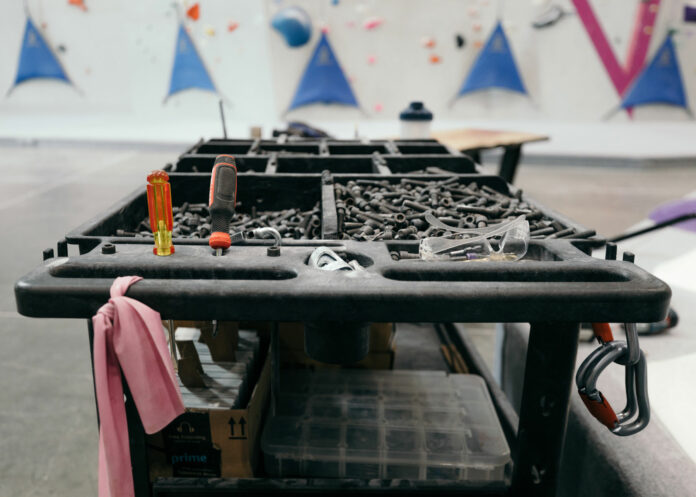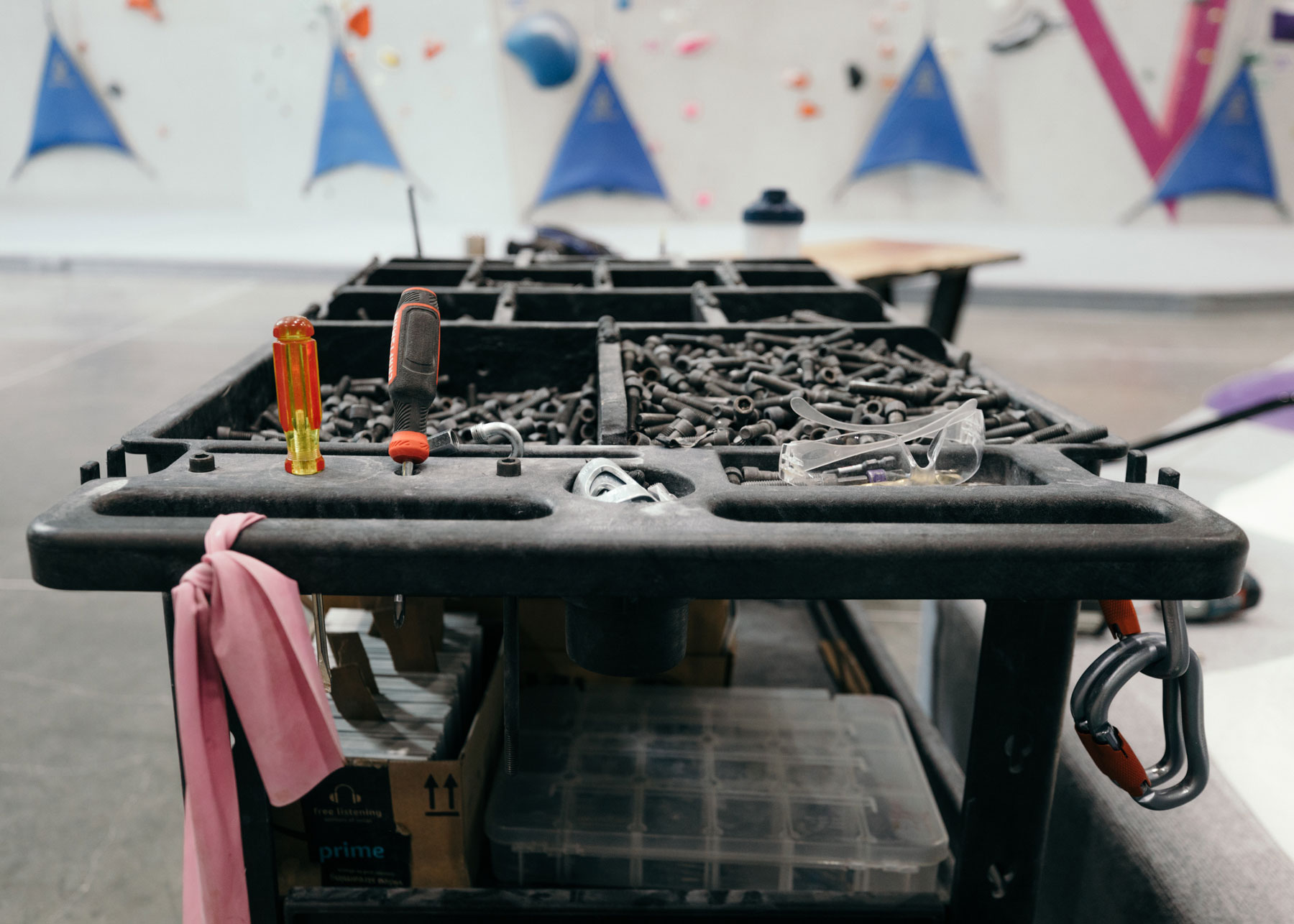
[Editor’s Note: This article was first published by Mountain Helt and Marlowe Kulley in 2015 and has since been updated and revised with the help of Jackie Hueftle and the CBJ editorial team. More essential routesetting tools can be found in the Essentials for Routesetting on Ropes and The Drill: A Routesetter’s Best Friend articles.]
Routesetters have been called “industrial athletes,” a title which gets to the heart of what setters do on a daily basis: an industrial design job which combines training, skill, and experienced decision making with a massive amount of physical labor that often feels like working construction.
Opportunities for setting education and training have been steadily increasing with the industry-wide push toward routesetting professionalization. As part of this evolution, each climbing facility needs to make sure their setting department has the proper tools and equipment that setters need to do their jobs in the most efficient and safest way possible. To that end, we have gathered a short list of some essentials that every setting crew should have on hand.
Before diving in, it’s important to note that setters need more than just fancy wrenches to do their job. They need grips—holds, macros and volumes—as well as bolts and screws to secure them to the wall and the equipment to fix things and do the securing (all of which are all considered tools of the trade). Yet so many managers have not set aside a yearly or, even better, a monthly setting department budget to help setters get the holds and tools they need. The amount of the budget is not as important as having one in the first place. For smaller facilities, a simple new set or two a month—along with regular screw/bolt refresh purchases and new drills and other tools when needed—should keep your program feeling fresh and functional. For larger facilities, an annual budget between $5,000 – $10,000 for holds—plus some extra dollars for bolts, screws and tools—will bring a lot of joy to your setters and keep your members excited to reach for that next hold. If you need inspiration, be sure to check out CBJ’s Holds, Macros & Volumes directory, annual Grip List Awards, and monthly Grip Report roundups of new grips hitting the market.
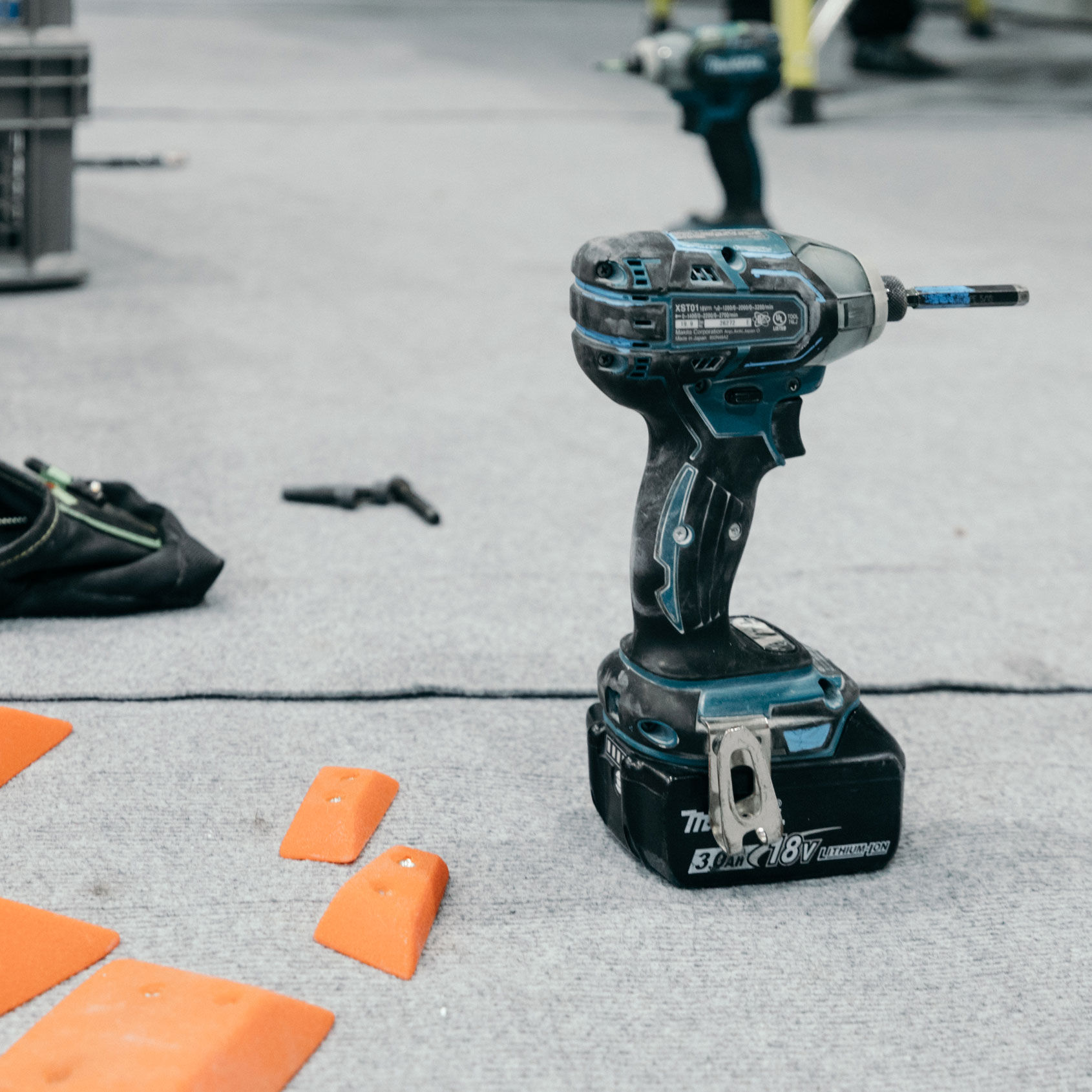
1. Impact Drivers
There are few pieces of equipment that are more important to the health and efficiency of a routesetter than a cordless impact driver. Impacts—often referred to as “drills” by setters—are fast to use, and their mechanical advantage puts less strain on the setter’s body while setting and stripping holds than other tools would. They also won’t knock a setter off a ladder like a regular drill can (if the clutch hasn’t been properly adjusted). Impacts are the best all-around option for setting departments, and the added efficiency gives setters more time and energy to focus on creativity—a win all around.
However, no two impact driver products are the same, and there are several factors to consider when choosing the right drill for your situation. We break down the ins and outs of selecting impact drivers in a separate article here.
Where to Buy:
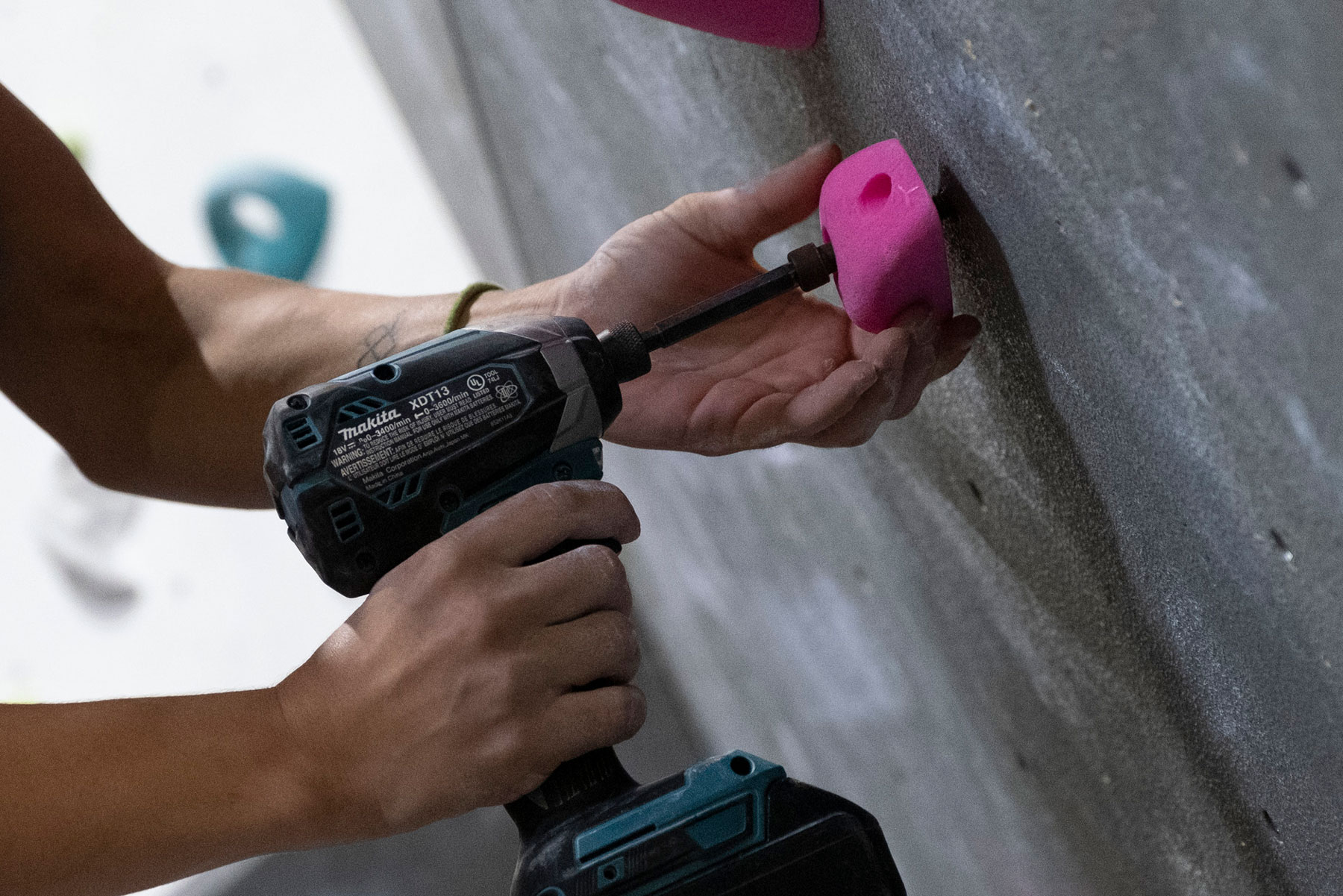
2. Drill Bits
A drill is no good without the correct bits. You will need hex bits to drive bolts and also the appropriate screw bits for whatever screws your facility uses. The most common sizes of these bolts in North America are 5/16” Hex for standard bolts (big bit) and 7/32” Hex (small bit) if you also use countersunk/martini bolts. For screws, T25 and T20 are common sizes, though some gyms use square bits, KTX, or other specialized fittings. All of these bits should be “impact ready,” meaning they have a quick-chuck nub on one end for easy in-out of the impact driver, or should be intended for use only in a regular drill (like if in addition to your impact you also carry a standard drill for woodscrew tightening).
Many companies have a few lengths of bits available, but some setters may prefer super long bits (which can ease the strain on a setter’s body); if this is you, you may also want to get a bit extender. Bit extenders can add several inches to the bit length, allowing a drill bit to be used for larger holds with deeper bolt holes or to get the bit head into tighter spaces. Bit extenders also reduce the arm travel for setters, and some setters believe they reduce fatigue over long setting days. There are different options available at most hardware stores and online; some options have thicker locking heads that may reduce their usefulness for setting purposes (aka won’t fit down a long bolt hole), so think through what you’ll need them for when buying.
Where to Buy:
- 3in, 2in, T-25 & HexStar Bits at Escape Climbing
- T-20, 5/16in, 7/32in Bits at Kilter Grips
- Milwaukee Bit Extender (shorter) at Home Depot
- Dewalt Bit Extender (longer) on Amazon
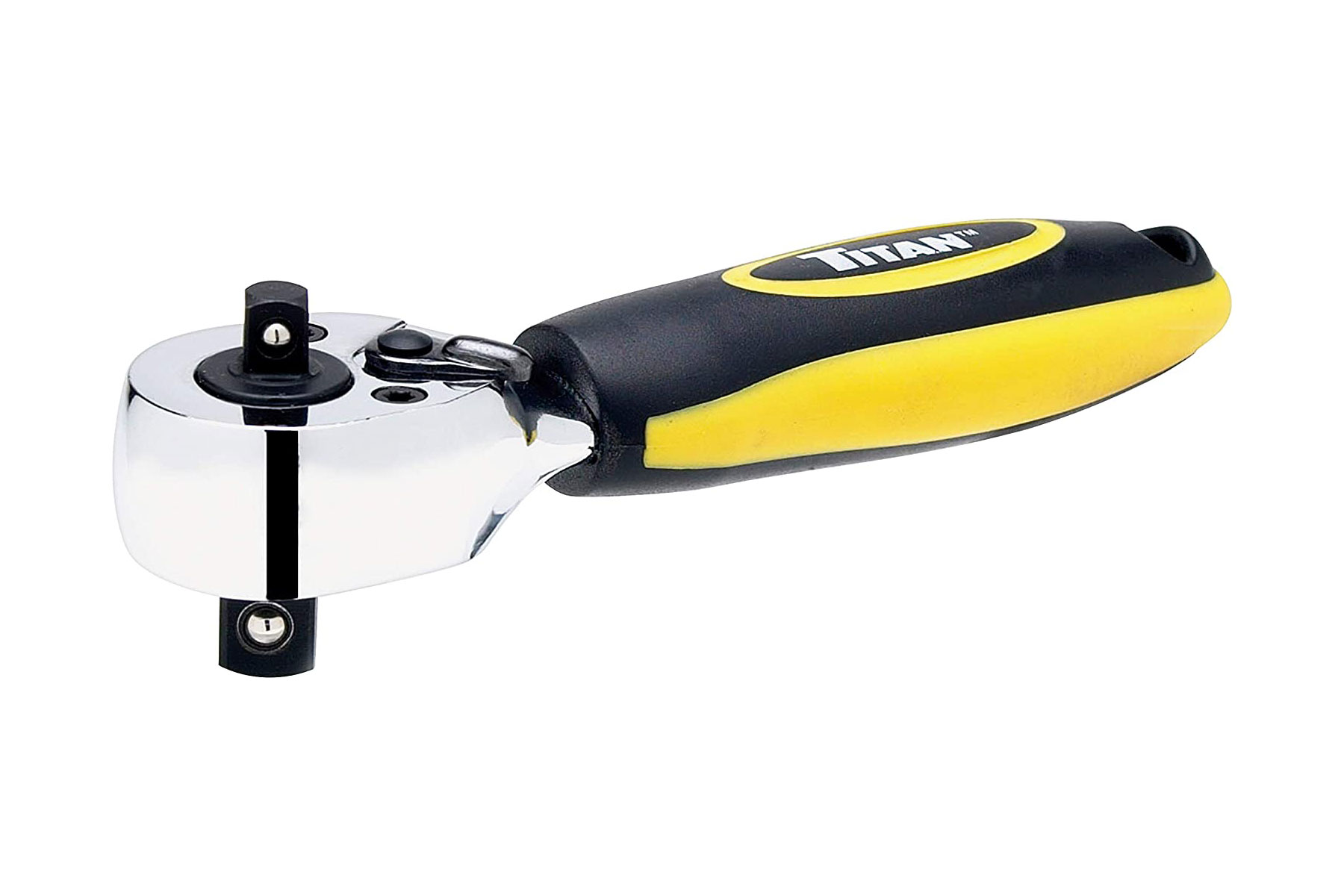
3. Ratchets and Breaker Bars
Some facilities do not allow impact drivers for various reasons, such as old, fragile walls or a negative customer experience due to the loudness of the tool. If your facility does not allow impacts, you still have a better choice than a T-wrench. What you need is a dual-headed stubby ratchet. These little wonders have two sides which will fit both types of bits you’ll need on the wall. They’re light and easy on the body, and they’re also great for forerunning.
If you use a ratchet, the most important thing is making sure you’re holding everything straight. Doing so keeps the torque going straight into the bolt and t-nut instead of creating a twisting system that can break your bit or wall.
For stuck holds, an extendable ratchet or breaker bar can help a ton. Extendable ratchets are nice because, unlike big breaker bars, these tools fit in a regular tool box but then can be lengthened to give you that important extra leverage when working on a cross-threaded bolt. Like with regular ratchet work, make sure the breaker bar ratchet is properly lined up to prevent breaking your bits through torque. Watch some videos online or seek mentorship to learn how to best utilize this tool in setting work.
You’ll also need the appropriate-sized hex on the right-sized drive (in this case 3/8” drive) to fit on your ratchet.
Where to Buy:
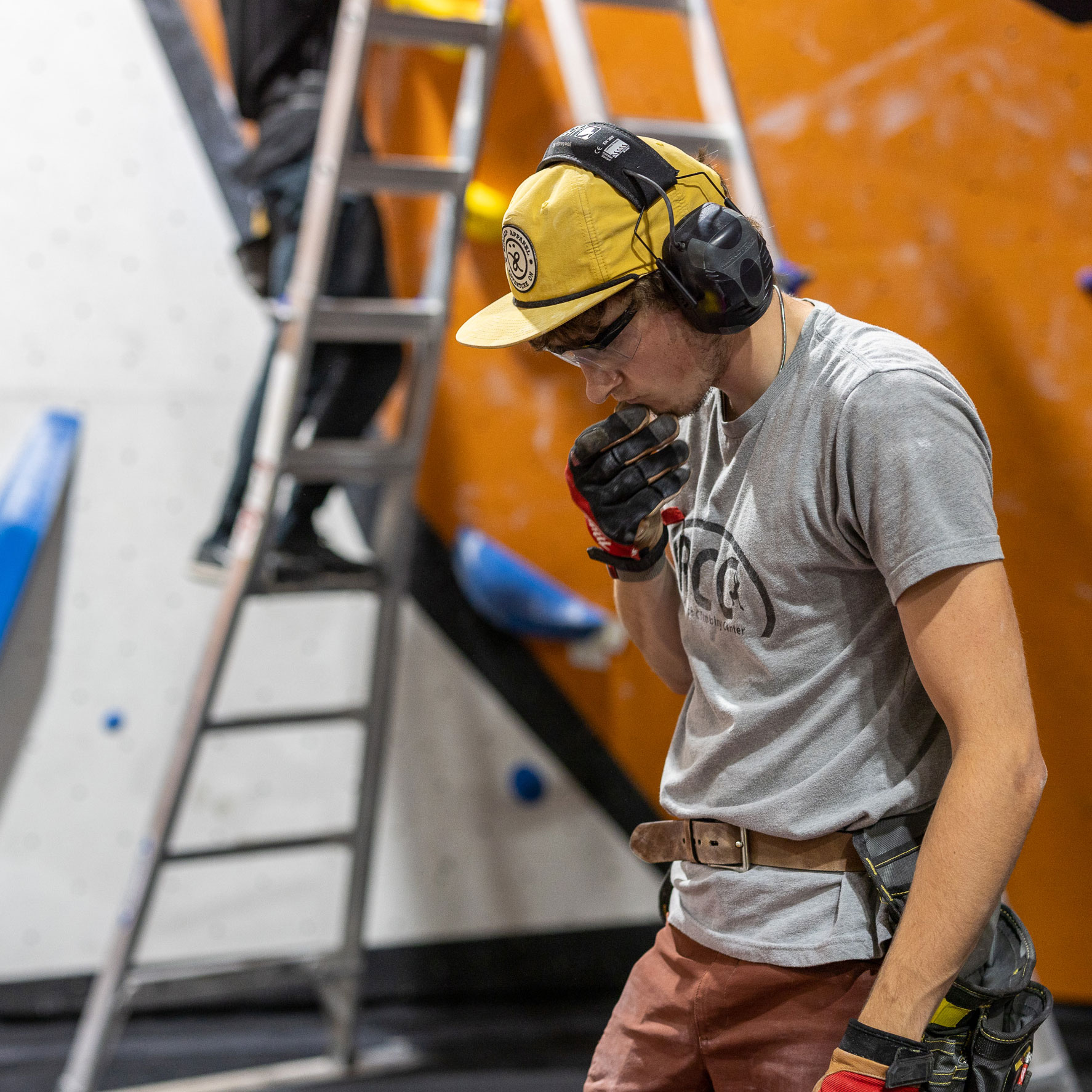
4. Personal Protective Equipment (PPE)
Some setters have gone 20 years without ever having to go to the ER for a bit of metal in their eye, while others have been in and out of emergency care like it was a burger joint. Regardless of your luck, ear and eye protection have become de rigueur for the modern setter, with other equipment like helmets, gloves, safety harnesses, fall arresters, rigging systems, and back-up lines becoming more common by the day. As setting professional standards improve, getting your program up to date with a Work at Height course and correct safety equipment is more accessible and more important than ever. (A separate article with essentials for routesetting on ropes is forthcoming.)
Ears
Impacts put out high decibels of sound, which is not only annoying but can result in hearing loss with prolonged exposure. Hearing protection in the form of cheap foam plugs or, better yet, full-coverage earmuffs or sound canceling ear plugs is the way to go. These days high-protective headphones are also available, giving you music while your ears are still protected from tool noise. No matter what method you use, make sure the other setters around you still have a way to get your attention if they need to!
Where to Buy:
Eyes
Safety glasses are an absolute must. Yes, they can be hard to remember to put over your eyes (vs. leaving them on top of your head), your eyes have to adjust to them when you put them on, they can steam up and limit visibility, and they can feel bulky or unwieldy. But with the use of high-powered tools in setting, their importance cannot be understated. Safety glasses are especially crucial during stripping and tapping, when metal shards are most likely to find their way out of the t-nut and into a setter’s face. There are plenty of good options for safety glasses available, and after a bit of habit-forming they’re not troublesome to use on a daily basis.
Where to Buy:
- Safety Glasses at The Hold Room
- Magid Safety on Amazon
- Stoggles Affordable Prescription or Standard Safety Glasses
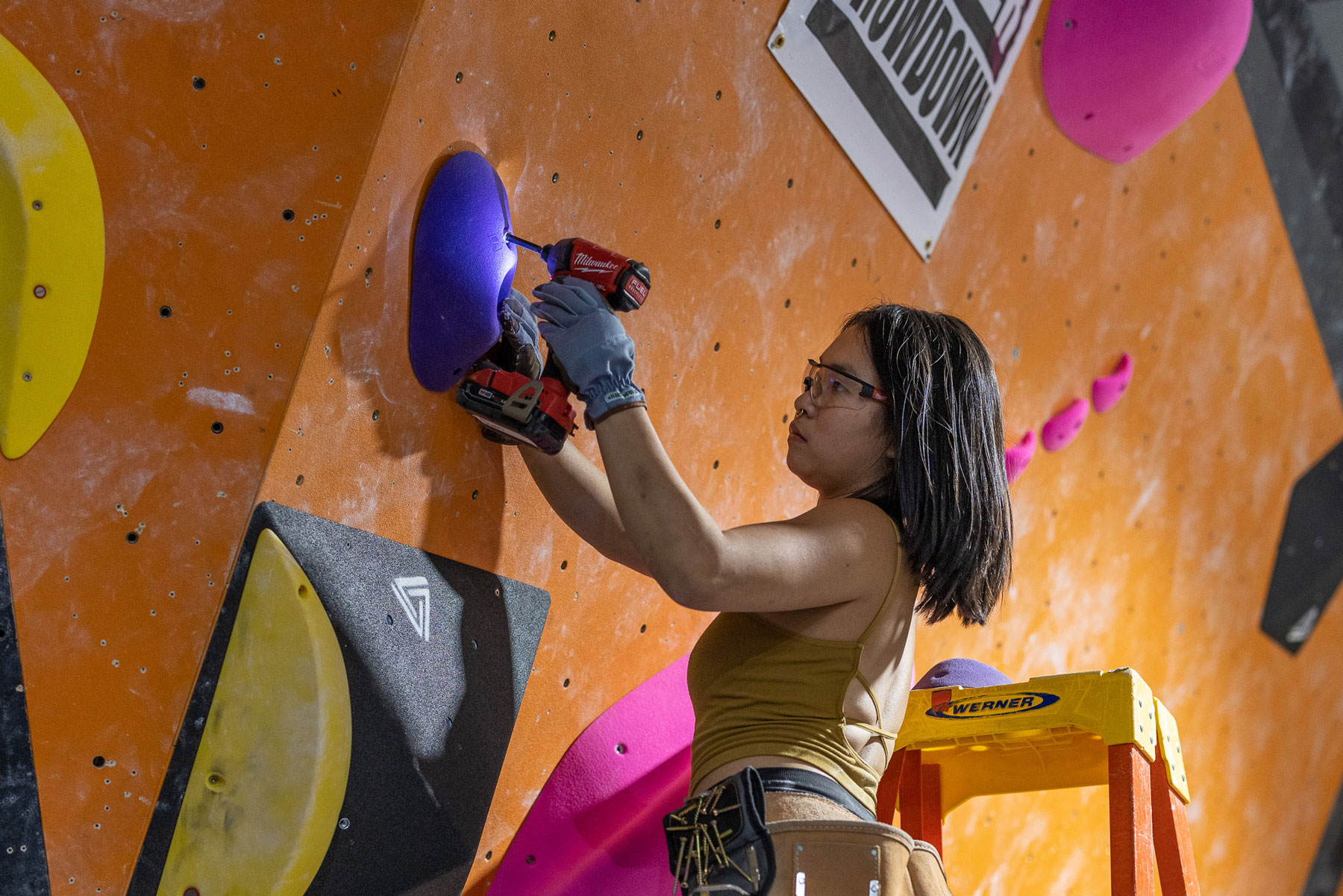
Other Useful Equipment
Gloves
Gloves can be great for rigging and hauling. Some setters even wear them while setting to keep their skin healthy, though if the gloves make your hands too sweaty it can have the opposite effect, and gloves can be dangerous around spinning tools like a drill-head. Consider them mostly for saving your skin when safe to do so. Climbing-specific gloves have fun features like clip-in points, but cheap hardware store gloves often work well enough to get the job done.
Where to Buy:
Barriers
Barriers are now recognized as a necessary item for a proper setting department to properly close their area and keep customers away from potential falling items and ground hazards. Some people go with road cones and construction fencing, but there are more fun, setting-specific options out there as well, like The Hold Room’s printed Safety Barriers.
Where to Buy:
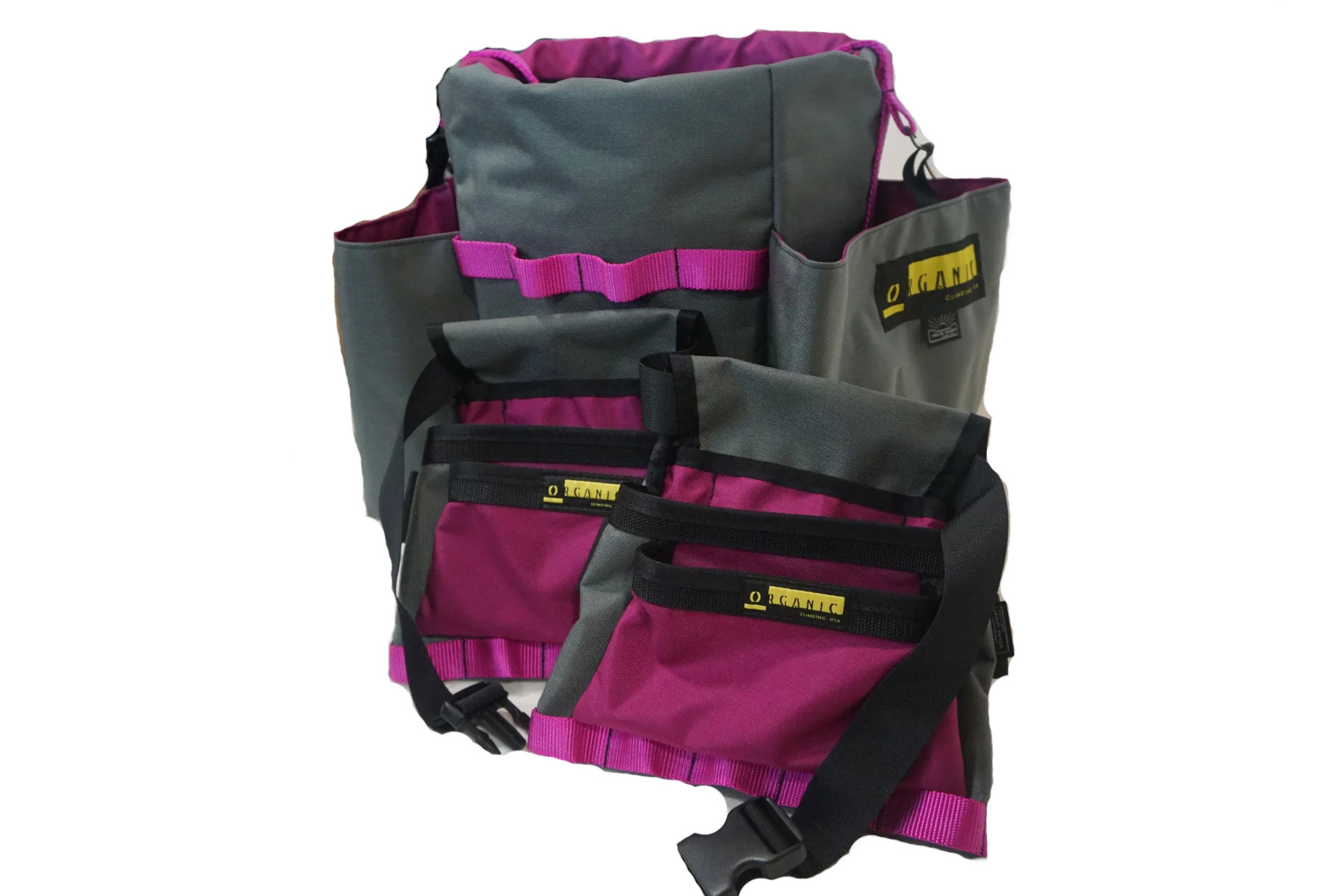
5. Tool Belt & Bucket Liner
Ye olde Homer bucket has served you well. Now let it go. Gear makers have caught up to the unique demands of hauling holds and setting tools and have created bucket liners and tool belts that are safer and more efficient. While tool belts are more essential than bucket liners when setting on ladders for bouldering rather than on ropes, bucket liners can be handy on-the-ground companions that come with tool loops, pockets for small footholds and bolts, tape loops, and other straps and pockets. Many liners are available in 5-gallon sizes (i.e. standard hardware store bucket), although larger 17 and 19-gallon versions exist (more often used for tall roped walls).
Whatever you bring with you on a ladder, make sure it’s impact tested and reliable, so that nothing will drop on the heads of other setters in the vicinity.
Where to Buy:
- Bucket Liner by Organic Climbing (5-gallon)
- Bucket Liner by So iLL (5-gallon)
- Bucket Liner by Flashed (10-gallon)
- Bucket Liner by So iLL (17.5-gallon)
- Bucket Liner by Flashed (19-gallon)
- Tool Belt by Kailas
- Tool Belt by Kanga Climbing
- Tool Belt by Organic Climbing
- Tool Belt by Squadra
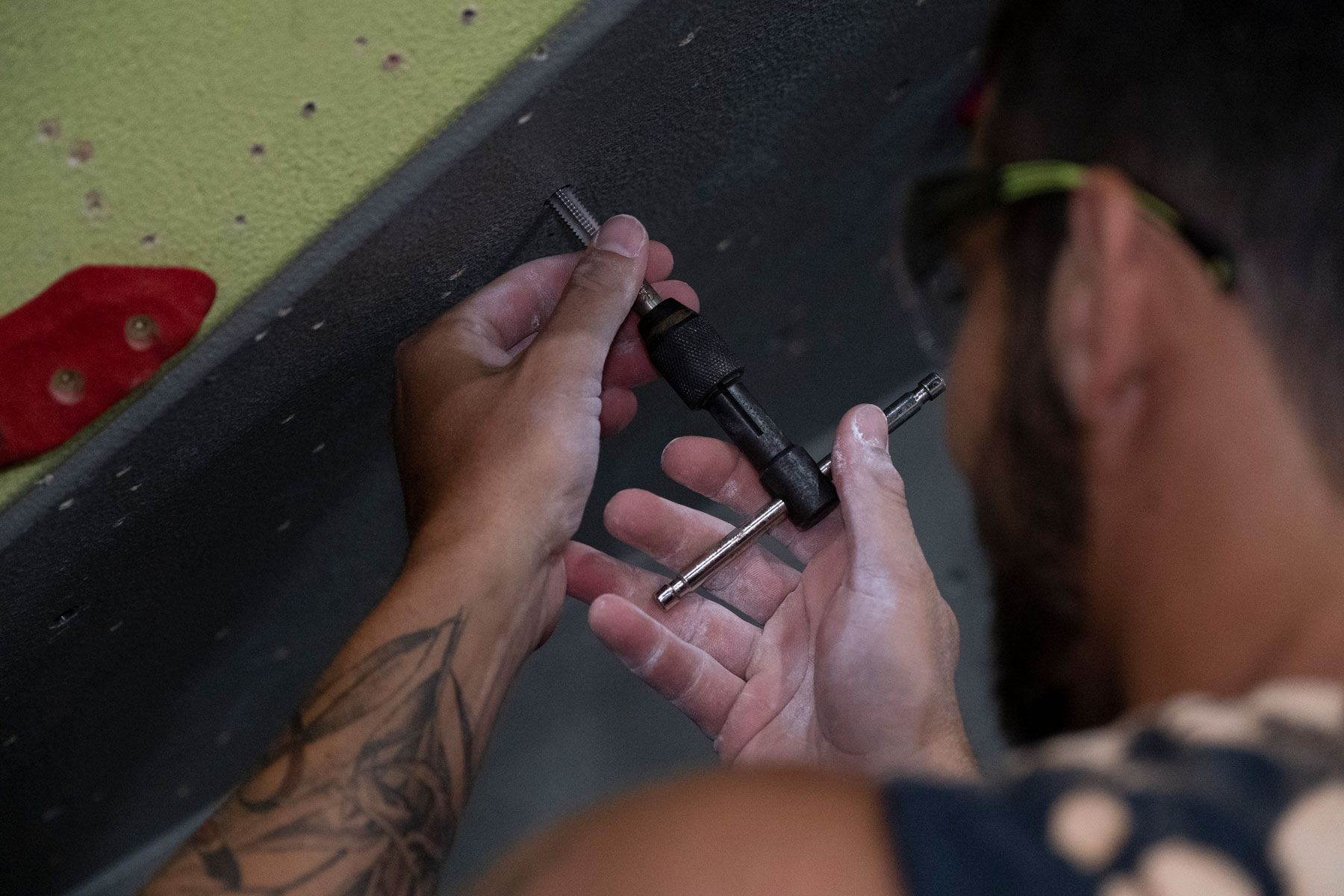
6. Tap
How can such a simple tool make such a difference in the life of a setter? A tap is a frenemy of the setters; if you need it that means that the T-nut you want to use is not threading properly and now you have to take the time to fix it with the tap, so that you can place your hold in that perfect spot.
When tapping, make sure everything is lined up straight, and be sure to wear safety glasses! Tapping creates metal shards that you want to keep out of your eyes and off the floor, so a catch-bucket and clean up afterward is an important part of the tapping process.
A tap can rethread a stubborn t-nut, clean out paint, concrete and other debris, and in general makes wall maintenance a more efficient job. Taps are inexpensive and easy to carry in a holster or setting bucket. There is also a ratcheting model that is a bit bulky but much easier on those stubborn t-nuts, though it’s also more likely to break your tap head if things aren’t lined up correctly!
Where to Buy:
- T-Nut Tap at Escape Climbing
- 3/8-16 Tap at Atomik Climbing
- T-Handle Tap Ratcheting Wrench at Harbor Freight
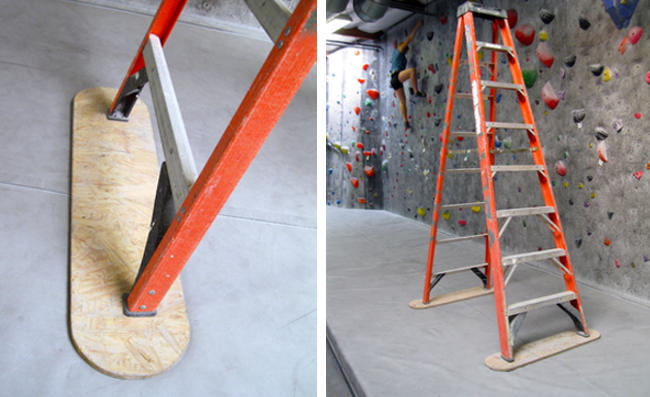
7. Ladder Skids
With modern setting for bouldering taking place on 12 or more inches of soft, tarp-covered padding, climbing an A-frame ladder is an exercise in balance control. Climbing a wobbly ladder is not only unsafe but is also taxing on your body. One way to stabilize the ladder is to lay a sheet of plywood or OSB on the padding to stabilize the ladder; however, dragging around a piece of plywood is incredibly inefficient.
Instead, permanently attach a length of wood to the feet of the ladder. Just be sure to sand and round the edges beforehand, so they don’t pierce the landing surface. These skids help mitigate the wobble without having a separate piece of equipment to carry around.
Where to Buy: Do-it-yourself project
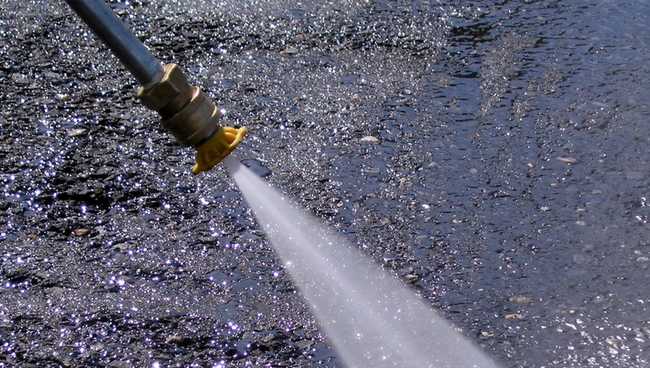
8. Pressure Washer
Each climbing facility will have its own system for cleaning grimy grips, and nowadays there are advanced hold washing machines that get the job done. For setters tasked with doing the chore by hand, washing holds is an undesirable task no matter how you look at it. But there is a simple way to make the job a bit easier. Blast that chalk and boot rubber off with a portable pressure washer. Sure, you can wash holds all sorts of ways, but setters that have been around for a while always come back to using a pressure washer to get the grips clean, when doing the job by hand.
Where to Buy:
- Pressure Washer at The Hold Room
- Hold Washing Machine by ClimbLab
- Hold Washing Machine by KleanHolds
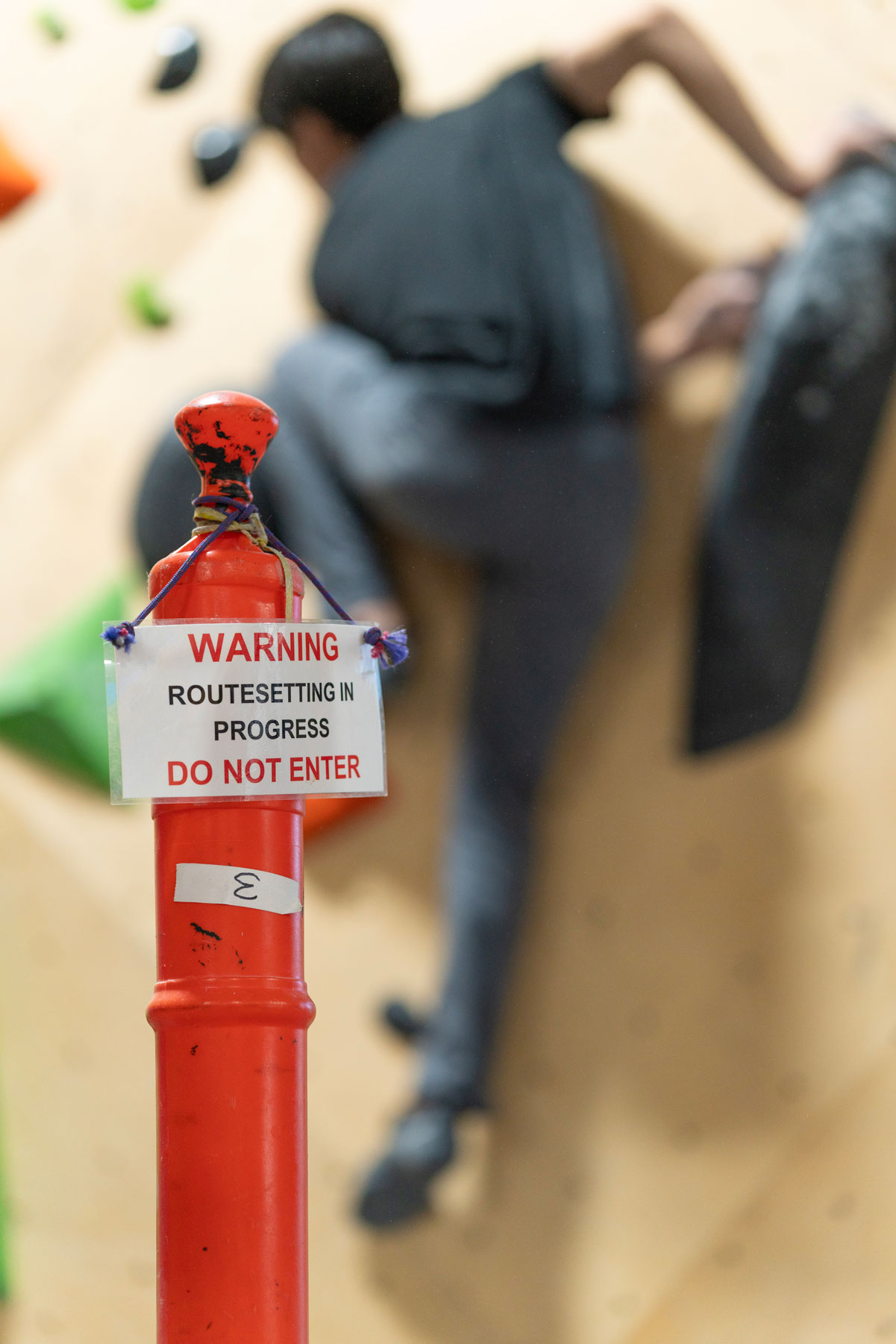
9. Training Procedures
If it’s not written down, it doesn’t exist. This statement is true for all policies and procedures in your gym, but it’s especially important for those working at height. For the most part, setters understand the safety demands of their job, but many owners and managers think that setting can be done by any knucklehead with a t-wrench and neglect to train setters in the mechanics of their job.
A few key questions you should ask yourself before you hire your next setter are: How is knowledge transferred to your setters? Is it by word of mouth, or is it through a comprehensive training program that starts with how to interact with customers and goes all the way to setting on ropes, in addition to setting for bouldering? Having a written training program and Job Hazard Analysis for different parts of the setting job could save you a headache and money if there is ever an accident involving a setter.
The ins and outs of good setting program safety are too much for this article, but we highly recommend seeking professional evaluation and training of your setting program’s work at height and worker safety programs. The CWA is constantly updating and refining their Work at Height program and has an upcoming Routesetting Guide as well, both of which can be used to better train and organize your program. Help your setters get Work at Height certified, and be sure to invest in some custom setting clinics for your staff, as well. Then use that collective knowledge to create your gym’s training manual and standards to help professionalize and protect your setters and setting program.
Where to Learn:
- CWA Routesetting Guide
- CWA Work at Height Certification
- Petzl Technical Institute
- USAC Routesetting Certification
- Route Setting Institute Instruction
- The B.I.G. Initiative Workshops
- Setter Showdown Events

Climbing Business Journal is an independent news outlet dedicated to covering the indoor climbing industry. Here you will find the latest coverage of climbing industry news, gym developments, industry best practices, risk management, climbing competitions, youth coaching and routesetting. Have an article idea? CBJ loves to hear from readers like you!




